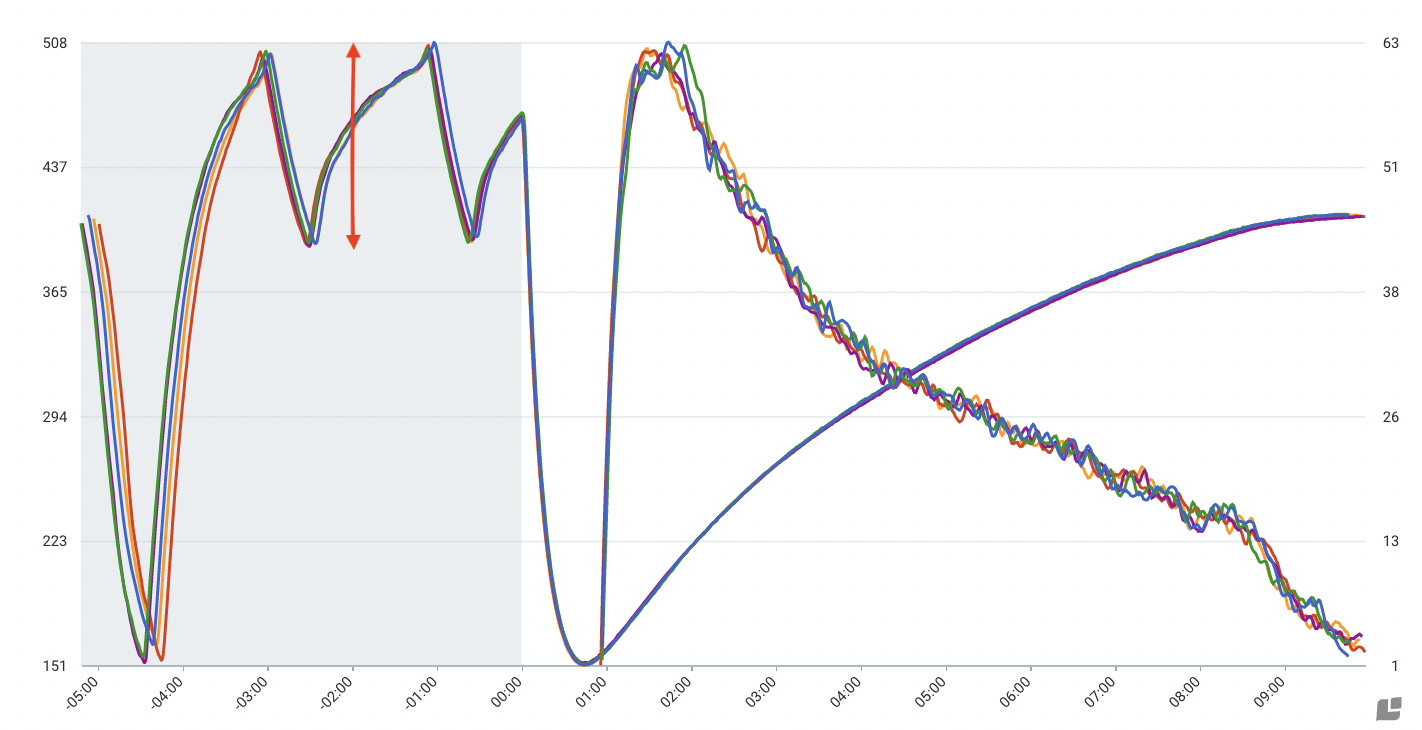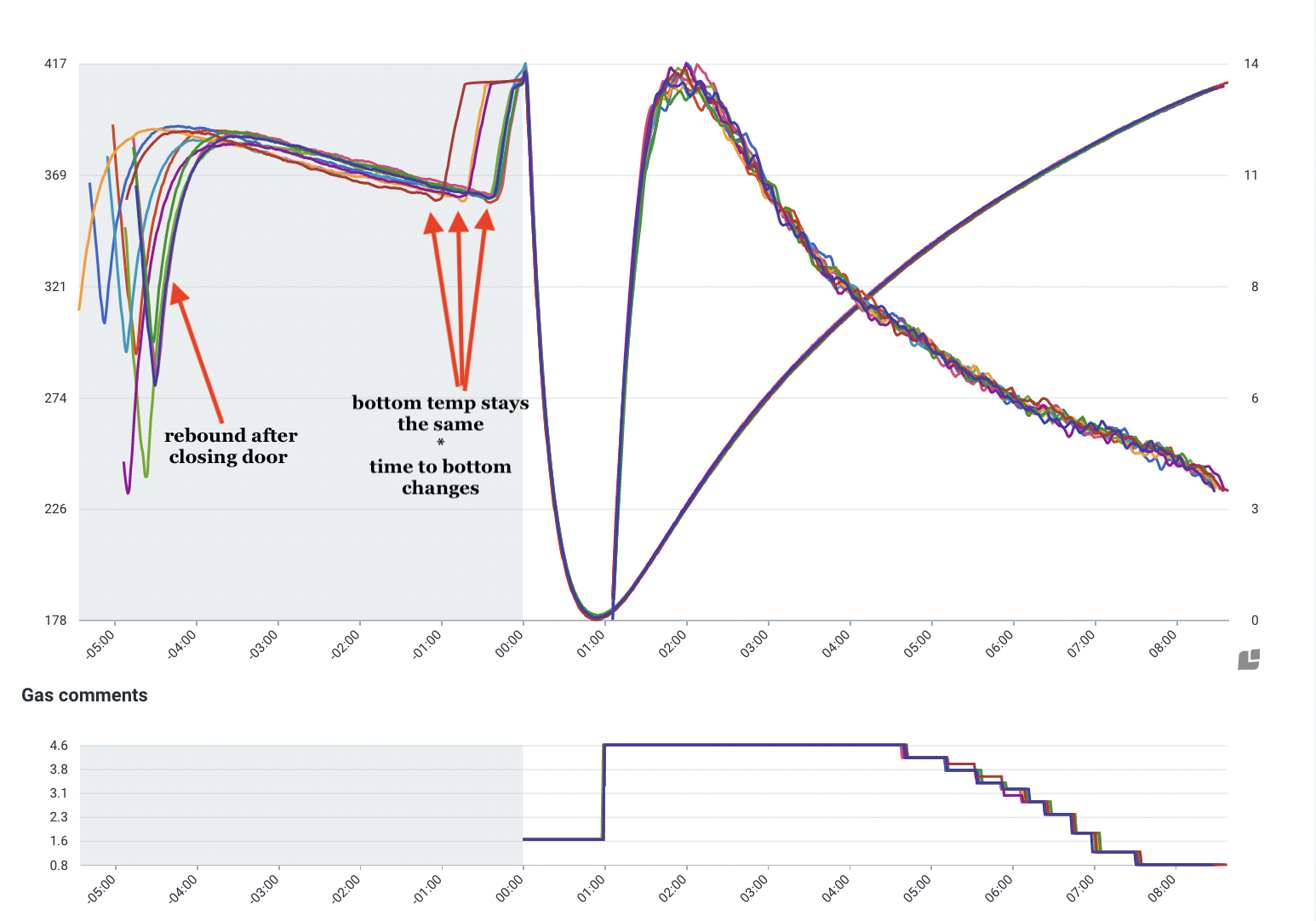Consistency in Roasting
Birth of the first effective BBP
When I wrote The Coffee Roaster's Companion in 2014, I coined the term “between-batch protocol,” something I had been teaching and honing with clients for several years. While there are some things I would change in CRC (and did, when I wrote Coffee Roasting: Best Practices), discussing how to design an effective BBP was probably the most important and impactful information in the book.
Roasters have always had some system between batches, but prior to 2014, I had never seen a roaster have an effective one. The most common practices were either idling at a certain BT or ET for some set amount of time or turning off the gas until the BT reaches a certain temperature. Neither system works well, and below I’ll explain why.
Several years later, at my urging, Cropster introduced a feature to graph curves between batches. Once roasters began seeing their BBP data graphed in realtime, many more roasters began realizing they needed better systems.
Teaching thousands of roasters how to design an effective BBP, roasters using data-logging software, and seeing the data in graphical form have all improve consistency in roasting. Unfortunately, there is a long way to go, as many prominent roasters are still in the “data doesn’t matter” camp (translation: their data is messy or inconsistent, so they dismiss its value), and I’ve yet to see a published scientific paper about roasting wherein the scientists first demonstrated their ability to replicate roasting results before comparing the results different approaches. One of the first rules of science is to verify that your results are repeatable. I’ve yet to see that verification.
Data and Cupping Results
Do differences in data translate to differences in the cup? Absolutely, yes. Of course, cuppers’ abilities to taste subtle differences in cups will vary. At Prodigal, we favor measuring variation in weight loss over color readings, not because color isn’t important — it’s critical — but because there are several flaws in the available color-measurement systems. More on that in a future post.
As you can see in the graph at the top of the page, while our data is not “perfect,” it’s extraordinarily consistent. A roaster friend whom I showed this to said “looks like fake data,” which is about the highest compliment I could ask for. Our lowest and highest weight loss for these batches of Basha Bekele (a gorgeous naturally processed Ethiopian sourced by Christopher Feran for Crop to Cup, and one of the coffees in our current Ethiopian Tasting Kit) were 12.0% and 12.13%. In a situation where the curves are nearly identical and the weight losses are 0.13% apart, that’s about the smallest variation that is still tastable to us, and the taste differences are almost negligible. I estimate we accept weight-loss variation of 0.25% from our target; greater variations end up in our discounted “first batch” offering.
The purposes of a BBP
The two main purposes of a BBP are to reset the “thermal energy” of the roasting machine, and, usually, to cool the chamber surfaces in order to prevent them from creeping hotter throughout a roasting session. What we are manipulating with the BBP is primarily the temperature of the roasting drum. Unfortunately, we don’t have a commercial solution yet for measuring the temperature of the drum, so I’ve designed BBPs using the bean-temperature reading as a “hack.” The BT does not indicate the drum temperature, which is why simply idling at a constant BT does not lead to effective roast replication. However, making the BT drop and rise in a controlled manner can effectively accomplish the two goals of cooling and resetting the drum or roasting chamber’s thermal energy.
Do we always need a BBP?
Short answer: no. In 2020, my partner Paolo at Regalia, the first roaster to master my BBP system, came to me with data from several hours worth of roasts of a Colombian coffee. The graphs replicated beautifully, and Paolo said “I did this with no BBP.” We had a fun discussion about how technically, you don’t need a BBP, but you can only get away with a no-BBP system if 1) you roast only one coffee, with the same settings, every batch and 2) the ending drum temperature is of a reasonable temperature for the start of the next batch. A BBP becomes essential as soon as a roaster wants to roast more than one coffee, use different settings for various batches, or roast batches to different degrees. In other words, unless you limit yourself to only roasting one coffee one way in a roasting session, you need a BBP.
Designing a BBP
There is no “one size fits all” BBP, but all effective BBPs share common features:
The gas is off or low enough to cool the drum/roasting chamber
The temperature of the air (usually the BT) in the empty roaster goes through at least one cycle of falling and rising (preferably in that order).
Some roasting machines limit the ability of the user to implement the standard BBP procedure. For example, Loring machines don’t allow the user to turn the gas off completely during the BBP. Such machines need slightly different approaches.
Below on the left is a successful approach to a Loring BBP I call the “two cycle” approach. One sets the minimum and maximum temperatures, allows the machine to cycle twice down to the minimum and up to the maximum, and as the BT rises after reaching the minimum temperature a second time, the roaster charges the next batch.
Below on the right is a typical drum-roaster BBP: the BT drops as the door opens and the gas is off, the BT rebounds strongly after closing the door, and the BT sinks slowly to the chosen “bottoming temperature.” At the bottoming temperature the user turns on the gas to a prescribed setting and charges when the BT reaches the charging temperature. The keys to a successful BBP are the choices for bottoming temperature, gas setting, and charge temperature. Rising too slowly or too quickly to the charge temperature, for instance, will make the BBP ineffective. Note that the amount of time it takes to reach the bottoming temperature will vary, but that is the BBP doing its job, acting as a sort of shock absorber for thermal energy variation.
My BBP template works on every machine I’ve ever used, though a few machines, such very large machines with power burners, and smaller, recent-vintage Diedrich machines, make a short, effective BBP challenging to design. In my seminars and consulting I teach hacks for such difficult cases.
Some roasters require a manual BBP, and some have a programmable BBP. Although they do not call it a “BBP,” Loring has a semi-automated BBP system. IMF’s (below) is quite simple to execute. Some manufacturers have gone so far as to create explicit BBP programs. For example, the Roest sample roaster and the Sivetz roasting machine have programmable BBP profiles.
automatically executes a programmable BBP profile as soon as one drops a batch, and beeps when the BBP is complete. The beep is simple, but brilliant; it allows me to ignore the roaster during the BBP, knowing I won’t miss the moment I should charge.
Sivetz BBP button
Last year I worked with Michael Barthmus, the new owner of Sivetz Roasting Machines, on modernizing the Sivetz fluid bed roaster. One of the my favorite upgrades Michael made is a programmable BBP button, which executes a pre-programmed BBP cycle.
Do Air Roasters Need BBPs?
Yes. While many air roasters allow the operator to use a shorter BBP than would be necessary on a classic-drum roaster, there is no roaster do date that does not require a BBP. Unfortunately, several manufacturers have claimed otherwise, but none has yet to share data showing effective curve replication without a BBP. I’m not holding my breath.
Prodigal’s IMF BBP
One of the reasons I started Prodigal was my frustration with roasters’ consistency. There has yet to be a time i loved a coffee from a roaster, ordered a second bag, and was as satisfied with the second bag. I’ve tried many times, the second bag has always been a disappointment. It seems unlikely a company would get worse at roasting a coffee, so the more likely explanation is that those companies’ roasts are too variable for consumers to rely on them to deliver excellent quality to every customer. As a roaster, I know how difficult that can be, but as a consumer, it drives me crazy.
At Prodigal, we are more consistent than any other roaster I am aware of (the only roasters who are close are all clients of mine), and despite our level of consistency, we still offer our good-but-not-perfect batches as our discounted “first batch” offering. Truthfully, we don’t have bad batches anymore, now that we have settled into a rhythm with the IMF. But we like to experiment, and “first batch” is now made up almost exclusively of experimental batches, rather than batches we just didn’t execute well.
The next time a roaster’s inconsistency frustrates you, ask to see their roast data in this format (curves, times, and weight loss numbers). One of three things will happen: either they will refuse (red flag), they’ll claim “data doesn’t matter” (red flag), or they will share messy data with you, confirming your suspicions. Of course, you could also just buy coffee from a roaster who invented the first effective BBP and is willing to share data publicly.
The three graphs above are of last weekend’s batches that went into our Ethiopian Tasting Kit. Our consistency allows us to sell such kits with the assurance that every customer will receive nearly identical-tasting beans.
—————————————————
Want to learn more about BBPs and roasting consistency? Join my October/November online class. The class consists of a 3—4 hour live, interactive video presentation (saved in the private class group online, to view as often as one wishes), and access to a private forum for one month. Class participants are welcome to post curves, ask me anything about coffee, and have an entire month to digest the class information and practice ideas discussed in the presentation.
As always, previous class attendees are welcome to join for 50% off. Please email me scott@scottrao.com for a discount code.









